|
an
account of a trip on the railway |
reproduced
from the Gazetteer

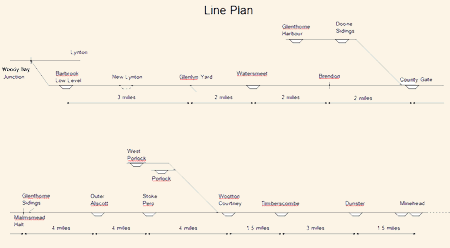
line plan - click on image to enlarge
Though Barbrook
is
the connecting station for the L&B and the M&B, the actual junction
is some
two miles closer to Barnstaple, in what may well be the beautiful location
ever mooted for the meeting of two railways, Woody Bay Station.

a double headed special enters Woody Bay en
route to Minehead
The L&B is at this point at the summit of its lengthy climb from Barnstaple,
980ft above sea level, and about to begin an equally sharp, but mercifully
shorter descent from Woody Bay to Lynton; in just over three miles falling
280ft (the majority of this being at 1-in-50). From this attractive station,
set on the high watershed but sheltered by a pleasant copse of trees, both
lines run parallel out of sight through a deep stone cutting. Upon opening of
the Minehead line, little modification was made to the station itself beyond
the replacement of the original signal box with a larger one standing
opposite the station building, and the addition of a double-crossover at the
end of the platforms to allow access to the new line; this junction marked
the official divergence of the Lynton & Barnstaple and Lynton & Minehead Railways, or as they
are now known, the Barnstaple & Minehead branch of
the Southern Railway.
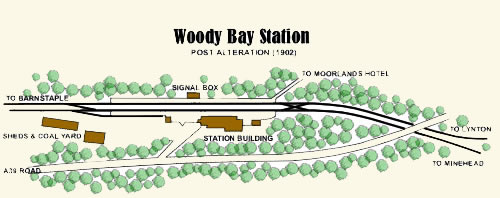
Despite its status as a junction,
the duty of the Woody Bay signalman was little different from those at Chelfham, Bratton Fleming or Blackmoor Gate, as through traffic from the
Minehead line was infrequent, with only a handful of goods trains a day,
accompanied by the occasional passenger working. This was a direct result of
the railways being treated as separate entities that just happened to share a
connecting line, despite the two companies having been intertwined under the
same management for their entire lives.
The cessation of passenger and goods workings to Lynton marked an end to this
arrangement, with the majority of trains now working directly along the
Minehead line. This brought about a reduction in status for the signal box;
as a cost-cutting measure it is now only staffed during peak seasons, with
responsibility for its operation during off-peak months falling to one of
Woody Bay’s porters, or on occasion (for specials and goods trains run at
unusual hours), the train crews. The working practice under these
circumstances is that a key to the box is attached to the section-staff, a
situation that is much to the liking of the staff, as it meant that when
needed, they no-longer have to rely on more ‘ingenious’ methods to gain access
to the box, (as in the days of independence when they saw fit to sortie under
cover of darkness to Pilton yard to ‘liberate’ rolling-stock for operation of
Minehead trains). Details of those ‘ingenious methods’ are undocumented, but
persistent stories repeated at the ‘Halliday Arms’ in Barbrook and the ‘Rose
and Oak’ in County Gate make reference to a series of skeleton and duplicate
keys machined up by a local smithy.
Immediately after departing Woody Bay the two lines vanish round the cutting
and pass under the main road to Lynton. Immediately, the Minehead line begins
to fall at a steep gradient through its own cutting, swinging away from the
original L&B; this marks the beginning of the steepest sustained gradient on
the railway. While the original line continues its gentler descent along the
valley side towards Lynton, the M&B dives fiercely down towards the river, on
a ruling gradient of one-in-thirty-five. While a pleasant enough downhill
jaunt on the through trains of today, return journeys face a hard slog.
Thankfully this steepest portion is shielded from the sea by the surrounding
land and woods, so trains have little else to fear aside from the gradient,
though during peak season and periods of heavy goods traffic there is always
one engine left on duty at Barbrook, should the services of a banker be
necessary.
|
BARBROOK HIGH
AND LOW LEVELS |

Still
falling hard, the railway continues to hug the same side of the valley as the
L&B; when the original survey was submitted to Parliament in 1899 it was
intended that on leaving Woody Bay it would cross the valley and then on an
easier gradient follow the opposite flank to Barbrook, where the West Lyn
river would be spanned on a small viaduct. However, George Newnes, local
landlord, chairman of the L&B, and opponent of both the M&B and its
promoters, the Halliday family, managed to get the bill defeated on the
grounds that this route did not make provision for stations at Barbrook
(being too high above the village) or Lynton (being on the opposite side of
the valley). In order to avoid having to resurvey the entire railway, a
deviation line was quickly planned out; as such, having fallen several
hundred feet in just two miles, trains now coast into Barbrook Station.
The station is preceded by a single span plate-girder bridge over what was
once a farm lane, part of which has now been surfaced to form the approach
road to the station. This marks the end of the steepest decent and the start
of a short section of level track through the platforms.
Barbrook was for years (until the closure of Lynton station), ‘Barbrook
Junction’, the terminus for Minehead passenger trains, bar a few exceptions.
Built on twin-levels, it forced passengers who wished to change trains for
Barnstaple (or vice-versa) to negotiate the farm track to the high-level
station, seventy feet up the hillside. For a while a set of stairs were
provided to connect the stations, protected from the elements by alpine-style
wooden gabling, but a series of nasty falls by less-than-sure-footed
passengers quickly led to their removal.
Barbrook High Level, less than a mile up-chainage from Lynton station, was
just an ash-surfaced platform with an austere concrete shelter little
different from that at Parracoombe, originally faced in wood to provide a
more welcoming appearance. A grim and silent place, save for the rustling of
the dripping trees that overhung the line and platform, it was far from
popular with passengers, but a necessary evil. Trains often only called here
by request, and due to a somewhat cavalier nature adopted by Lynton drivers
regarding their Minehead cousins, would often drop off passengers for
Minehead knowing they were leaving them stranded due to lack of motive power
to provide the connecting service.
Barbrook Low Level, or as it is now known, just Barbrook, is a far more
welcoming place than the High Level halt, and a strange atmosphere of
‘busyness’ reflects it’s status as intermediate passing-point on the new
‘main line’. Though the waits between passenger services can be long and
tedious, there always seems to be something on the move, be it a through
coal-train, two trains passing, or just one of the older Manning-Wardle locos
pottering about between turns as a banker, shunting trucks like a much-loved
but aging relative put out to pasture. These however are scenes little
different from elsewhere on the line, and the truth of the matter is that the
buzzing atmosphere is spill-over from the adjacent ‘Halliday Arms’ inn, who’s
patrons regard the station as a convenient extension of the beer-garden. The
‘Arms’, built by a member of the railway-promoting Halliday family to snub
the rival Newnes dynasty, is built in matching Nuremburg style to the station
itself, and being sited adjacent to the main booking-office on the
approach-road seems to have been happily absorbed into the station proper.
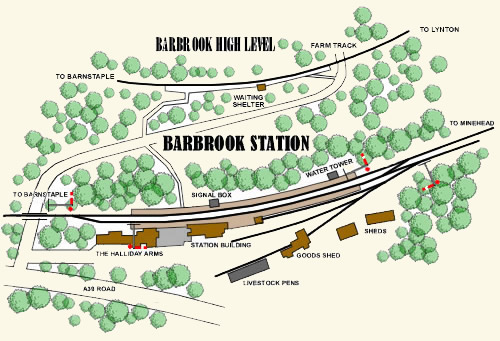
In
additional to the station building and its attendant ale-house a copious
goods-shed is provided, along with ample sidings, cattle-docks and sheep-pens
for local wares, along with a few clapboard-and-cement warehouses thrown up
more recently. Two platforms stagger a roomy passing-loop, overseen by the
gables of the station building on one side, and a tidy signal-box on the
other, set back into the cutting wall with a commodious view over operations.
Being the current station for Lynton and Lynmouth as well as Barbrook makes
it also a prime destination on the line for tourists and holidaymakers; as
such it is fully-staffed during the summer months to maintain a crisp and
tidy turnout that is lacking elsewhere on the system. With its trim
flowerbeds and hanging-baskets, freshly repainted woodwork, quaint trains and
the guarantee of at least one Halliday patron sunning himself on the
platform, pint-glass in hand, the station is charming in it’s immediateness
and cosiness.
On this particular afternoon, Friday June 7th 1935, there are several groups
of Halliday’s friends mingling with holidaymakers on the platform. The sun is
high and golden, and the sounds of bees going about their honey-making is a
pleasant bass to the alto-like gurgling of the overflow valve on the large
water-tower adjacent to the signal box, all set to the tempo of Lyn’s
injector-pump as she simmers on the goods yard headshunt. Soon a soprano-like
whistle-cry asserts itself, and with a familiar rattle of wheels on rails Lew
emerges from the cutting marking the start of the climb to Dean Steep and
crosses the road bridge into the station. Behind her follow three coaches,
including (to my pleasure), ‘the special’; another product of the spats
between the Newnes and Halliday families, ‘the special’ was a private saloon
built at Pilton Works from an old coach body. Now designated as the
first-class observation saloon, it includes an open section at the Minehead
end from which a commanding view can be attained over the splendid scenery,
the railway, and the engine at work.
There is no immediate rush to board the train however. Most of these
passengers are headed in the opposite direction, and so while a few
overzealous souls scramble to claim seats, Lew’s crew uncouple her and (with
a wave from the signalman) they and their engine disappear off down the line
on some secret mission, quickly running out of sight round the curved
platforms. A deeper-throated American chime whistle sounds out, and Lyn,
proud product of the Baldwin Workshops in Philadelphia, eases from the
headshunt, and through a series of reversals and point-changes, finally
coupling smoke box on to the train, ready to draw us onto Minehead. Her tanks
are full to brimming and her bunkers are well-coaled, and once again it seems
departure is imminent, but even as part of the mighty Southern Railway this
narrow gauge line dances to it’s own tune, and while waiting for the guard
the chance makes itself to have a friendly word with the crew.
It’s a pleasure to find Johnny Shobdon on the footplate. A veteran driver and
a wry wit he’s known as an artisan and craftsman of the highest order, and
this talent with his hands has resulted in some exceptional models of the
railway’s locomotives and rolling-stock.
Soon the guard emerges from the tap-room of the Arms, a basket swinging from
his hand. This has been stocked with bottles of chilled water and various
tonics, all to be kept chilled in the guard’s compartment. He’ll be offering
them to the passengers along the journey (for a reasonable fee of course), as
many will underestimate the effect Devonian (and Somerset) sun can have on a
dehydrated body. By this point anyone who had hurried to board the train has
disembarked back into the throng on the platform, and a sudden burst on the
guard’s whistle sparks a second rush. Those familiar with this routine
(myself included) will have already gotten into the special’s open-sided
compartment, and with a second signal from the guard and a response from the
engine, the train sets into juddering life towards Lynton.
|
VIADUCT QUARRY AND QUARRY
VIADUCT |
Falling once more at one-in-forty-four, Lyn
quickly gains speed down the gradient. It can seem alarming at first, but
Johnny knows his steed and her road in the manner that only years of
familiarity can breed, and with brief touch on Lyn’s brake we thread the
needle of the first road-bridge over the line (Station Hill), then emerge
from below Knibswothy wood and clatter into the outskirts of Lynton, with
houses below and above us. A pair of gentle reverse curves brings us to the
bottom of the gradient and an unofficial stop, Viaduct Quarry, a small quarry
opened out during construction of the line to provide stone for the
earthworks. The formation here is very wide and convenient for Lynton town,
as after Newnes raised objections to the original route, a station was to be
built here, hence why smarter passengers may tip driver or guard a wink (and
a shilling) to drop them off here rather than face the uncomfortable
charabanc connection between Barbrook and Lynton.
Due to another about-face by Newnes when his
obfuscation failed to prevent the passage of the railway through parliament,
‘New Lynton’ station was never built, but there is word about that the
Southern Railway may be considering relocating the station buildings from the
former Lynton terminus to this site to better serve the holiday traffic.
Easing travel for the locals is a secondary benefit as far as Eastleigh is
concerned, but it is felt in the area that if this step is taken, it will
demonstrate a long-term commitment on the Southern’s part to the railway’s
future.
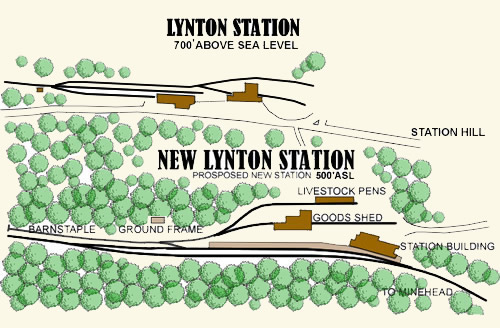
Today however there is no-need to stop, and
Johnny gives Lyn a burst on the regulator as we accelerate through the
overgrown shunting-loop and sweep hard right (with a flash of sparks from the
guard-rails) out of the quarry and onto a high embankment that leads to the
first of many dramatic pieces of engineering on the line, the crossing of the
West Lyn valley on the Glenlyn Viaduct.

the Glynlyn Viaduct from Lynmouth
One of seven viaducts on the line, Glenlyn (or to the railwaymen, ‘Quarry
Viaduct’, a rather confusing but amusing reversal of the name for the
unofficial halt that precedes it) was the first to be built, with the
railway’s ‘cutting of the first sod’ ceremony taking the form of laying the
viaduct’s first foundation stone. In this location, exposed to the sea,
construction was arduous, particularly when building the arches, diverting
much-needed time and finance away from the other viaducts which had to be
finished ‘on the cheap’ with timber decks carried on brickwork piers (the
wood later being replaced with wrought-iron). The result however is a
striking masterpiece wrought in salmon and cream brick, striding 81ft high 930ft across valley, road and river with an Olympian certainty in
its fourteen-arched-step. Poised on the lip of the valley’s final plunge down
to Lynmouth, the viaduct is highly visible and a local landmark. For
passengers, an unobstructed view may be gained over Lynton below and Lynmouth,
the Bristol Channel, and the Welsh coast beyond, a highlight of the trip.
Immediately after clearing the
viaduct’s eastern parapet we swing back left alongside the valley, passing
yet another small quarry and what Lynton drivers once mockingly referred to
as ‘Little Pilton’, Glenlyn shed, the main locomotive facility for the
Minehead line. When this section of the railway was opened in 1902, a
two-road carriage shed and a short engine shed large enough to hold three
locomotives were provided here, under the misconception that when ‘New
Lynton’ was built, this would become the operational centre of the railway;
as seen this never occurred, and Glenlyn was allowed to deteriorate. Other
facilities included a small turntable and a single-road building known as
‘the shop’, which mostly served to house a growing number of discarded or
broken tools and parts, indicative of the derision in which Barnstaple crews held Glenlyn.
Now however the yard has seen a transformation; with new locomotives and
rolling stock arriving throughout the last decade, and land for expansion in
Barnstaple and Minehead being lacking, the Southern has opened out the quarry
for ballast and used the land created to expand the Yard. Today, ‘Little
Pilton’ is on par with its namesake in terms of importance. Both engine and
carriage-sheds were enlarged, ‘the shop’ has become a dedicated paint-shop,
the turntable was replaced with one of larger diameter, and in the winter of
1933/34 a facility was established to maintain and house the new railcars
that are being introduced to the line.
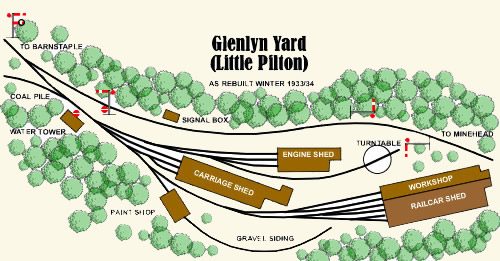
From the end of the viaduct a
single spur off the main line fans out to serve the engine
and carriage sheds. A siding extending along the side of the
carriage shed, previously used solely for storing ‘junked’ rolling stock, has
been extended and re-aligned into the new railcar facility, a six-road
building, two of the lines being separated off from the running-shed in a
dedicated workshop with specialist maintenance equipment. Against the bank is
another large water-tower and an ample coal pile, where Lew is taking
refreshment after bringing her train this far from Barnstaple. In the shed
Lyd, one of two ‘Baltic’ tanks obtained from North British for the extended
railway in 1901 (her sister machine being Axe), simmers idly; having just
undergone a heavy overhaul, a slow fire is being built in her to check for
any boiler leaks.

staff pose at Glenlyn
As noted, Glenlyn was not well provided for at first, but as Lyd will
testify, can now undertake major overhauls; indeed the new workshop has
become the railway’s premier maintenance facility. As the enlarged engine
shed can comfortably hold six ‘larger’ engines, the Baltics and the two
Mallet tanks built by the Southern (River Avon and River Brue) are maintained
and shedded here, in addition to the newly arrived Armstrong-Whitworth diesel
River Avill. Scenically, Glenlyn also boasts an unrivalled location
overlooking the valley, made all the more picturesque by the immediate
proximity of the viaduct; were a ‘New Lynton’ station built directly across
the viaduct from the sheds then this would be a railway location of beauty
unsurpassed in Britain, but whether this becomes a dream or reality remains
to be seen.
|
EAST LYN VALLEY TO
WATERSMEET |
With those
same magnificent views still in sight off to our left, Lyn accelerates along
a wooded ledge cut against the hillside, eventually swinging round many
hundreds of feet above Lynmouth to enter the East Lyn valley. From the road
through the valley bottom the train can only be perceived as a high line of
steam following the wooded counters, then winding and twisting along the open
flank of Oxen Tor which rises overhead with a majestic solemnity. Rolling
over gentle downhill gradients, through rock cuttings and thick trees, Lyn
leads us on, seemingly through not only space but time into some primeval era
of British history.

"wooded ledge cut against the hillside" -
photo - Glenthorne Estate
This mile-and-a-half of line is among the most inaccessible sections of the
railway due to its high position relative to the surrounding roads, and only
the occasional intersection of railway and footpath serves to break this
sense of isolation. These crossings are all unofficial halts, like Viaduct
Quarry unmentioned in any timetable, but blessed with evocative names such as
Lyn Cleave, Summer Hill, For Wester Wood, and Myrtleberry Crossing. The last
is very popular among the cannier holidaymaker, as there is much of interest
to be found in Myrtleberry Cleave, especially to those of an archeologically
or historical pursuit, chief among them Iron Age fortifications and the
remains of some long abandoned iron mines. With the coming of the railway
attempts were made to reopen these workings to supplement the traffic
returns, but the ore yielded was of a most inferior grade and the venture
collapsed as quickly as it had been mooted.
In addition to these human items of interest, the landscape is itself of a
most attractive character, and dismounting at Myrtleberry Crossing, three
miles from Dean Steep provides a more convenient access to such wonders than
the official station of Watersmeet, some twenty-five-chains up the line.
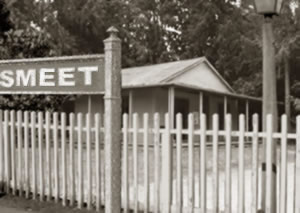
the Myrtleberry Tearoom from the
station platform - photo - Glenthorne Estate
The approach to Watersmeet features a pair of
impressive curves, first swinging us north, then back onto the original
eastern bearing. Check rails were laid in here with good measure, and so as
we grind our way round the second curve into Watersmeet the smell of hot
metal is evident in the air. Johnny shuts off steam well before we reach the
station throat, and the resistance of the coaches through the curve is enough
to bring Lyn to a stop with but a touch on her handbrake to firm the deal.
Regular passengers now crane their heads from windows to observe a series of
arcane gestures and hand-signals between driver and waiting stationmaster –
there is almost always a passing of trains at this station, and judging by
how the stationmaster is tapping his fob-watch it seems the other train will
be some time yet, so we might now (if we choose), dismount to stretch the
legs and savour the atmosphere while we await the passing train.

On closer examination the long-suffering
stationmaster is red-in-the-face; a recent transfer from some vital outpost
of the Southern network he is used to timetables being adhered to with
religious fervour, and his displeasure at the lateness of the ‘up’ train is
evident. Johnny however is far calmer, choosing to stuff his pipe and
remarking with a philosophical bent that the delay is no doubt ‘the work of
The Beast’. Judging by his contented puffing we have a few minutes at least,
so an exploration of the station seems in order. With heavy forests flanking
the hillside station above and below, the impression is given of staring down
a narrow corridor with only a thin slice of sky visible above; ahead of us
the line runs straight and true, springing across the second viaduct on the
line to the portal of the first tunnel at the foot of another high and wooded
flank of Exmoor. Overall the impression of the station and little train in
such a large landscape is both quaint and impressive, lying somewhere between
alpine splendour and the green and pleasant land.

this section of the line suffered landslips
Opened in 1906, there is no local traffic at Watersmeet, and it was built
primarily to provide a more convenient passing-point between Barbrook and the
next loop at County Gate. The passing-loop for this section was originally
some two miles further on at Brendon, but when that proved to be
operationally inconvenient, it was relocated here. Since trains might often
be kept waiting (as we now find ourselves) it was thought best to provide
passengers with the means to dismount and stretch their legs, and so the
station manifested.
The facilities at Watersmeet were once little better than those of Barbrook
High Level, yet in contrast to that dismal halt this is now among the
prettiest stops on our journey (though it is safe to say that few of the
stations are anything less than beautiful). Comparisons are often made to
Chelfham on the Lynton-Barnstaple section, with a proper and complete station
building of charmingly tiny size, two platforms and an equally modest signal
box with the associated array of semaphore signals. In 1910, the same year
that the Glenthorne Hotel opened at County Gate, a tearoom was established by
the Hallidays adjacent to Watersmeet Station, ‘The Myrtleberry’, which does
good business from walkers and explorers who have made this their
station-of-choice for exploring the East Lyn Valley.
The greatest attraction in the area is
Watersmeet House, built in 1832 by another member of that familiar brood, the
Reverend W.S. Halliday. Seemingly the good reverend enjoyed pastimes of the
body as much as of the soul, as Watersmeet House was commissioned
specifically as a fishing lodge. Thrown open to the public by the Hallidays
some years ago, it now makes a fine earning as a sister tea-room and shop to
the Myrtleberry. The fishing, incidentally, is excellent.
As we return to the station a
deep-voiced cry chills the air. As we look along the line for the source of
this whistle the nose of an engine emerges from the distant tunnel. The
locomotive crosses the viaduct with a great show of steam and noise and
swings over the points into the up-platform, revealing its prodigious length
and size. It is a monster of a machine to those accustomed to the barking
little locomotives so beloved of this area, an iron dinosaur snorting and
breathing anger and defiance as much as it does steam and smoke. As it comes
alongside our train three ominous digits can be seen painted on the cab side,
‘666’. This is ‘The Beast’ to which Johnny earlier made reference.

'River Avon' at Barnstaple circa 1930 - photo Southern Railway
In the 1923 grouping the Southern
Railway found itself lumbered with nearly fifty miles of run-down
narrow-gauge railway which promised only small returns. Tied to the railway
however, and determining to make the best of its lot, the men of Eastleigh
and Waterloo have in recent years begun experimenting with new technologies
to streamline and improve traffic on the ‘Lynton and Minehead’ branches. The
first of these experiments was number 666, delivered in 1925. Seeking to get
a more powerful locomotive onto the line, in order to do away with the
expense of double-heading, Eastleigh Works took the design elements of the
‘classic’ Manning-Wardle tank-engines and expanded on them to produce an
0-6-0+0-6-0T Mallet articulated tank-engine, which promised a huge surplus of
power without sacrificing the ability to negotiate sharp corners, a
not-dissimilar principle to the highly successful ‘double-Fairlies’ of
Festiniog Railway fame. Things however, did not go as planned.
The locomotive numbered 666 seemed cursed by ill fate from the second it
touched the metals of its new home. Eastleigh had dubbed upon it the name
River Avon, but no-one on the railway would refer to it as such, as there was
already an ‘Avon’ on the line, the County Gate station cat! In trying to find
an alternative moniker for the engine, it became known as ‘The Mad Mallet’.
Though harmless enough in itself, this name soon seemed justified as a run of
ill-luck continued; not long after entering service a man riding (in
violation of regulations) on the engine’s leading platform was thrown off
during shunting at Blackmoor Gate and suffered several broken bones. An
embankment collapsed under the unprecedented weight of the machine, it spread
the rails, rode roughly and proved extremely temperamental (track ties were
very quickly installed where rail spreading had occurred).
The culmination of these
unfortunate events however happened one year to the day of its arrival.
During a thunderstorm, while working a night train of coal down the fearsome
Porlock Incline, 666’s train managed to separate.
666’s driver, feeling his vacuum brakes come on, moved quickly to safely
check his remaining wagons, coming to a halt a few hundred yards down the
line, and sent his fireman back up the incline to find the rest of the train.
Meanwhile the guard, though realising his situation, panicked and chose to
run down the line in the hope of finding his engine. In his rush, he failed
to pin down the handbrakes on his stalled trucks, with the result that once
the vacuum brake system ‘bled off’, the weight of the train on the gradient
overcame the brake in the van. Disaster was unavoidable.
The surrounding storm and fury made a comprehensive account of what followed
impossible, but the runaway trucks soon overtook the guard, shot past the
fireman and collided with the leading section of the train at nigh on thirty
miles an hour. The driver was seriously injured and all of the train was
smashed to matchwood, except for number 666, which escaped relatively
unscathed. The sinister coincidence of the date, coupled with the horror of
the disaster, was the icing on the cake. What had once been nicknamed ‘The
Mad Mallet’ was now and hereafter ‘The Beast’ and only the most confident (or
foolhardy) of crews would drive and fire her.
Not long after this ‘incident’, engineers from Eastleigh arrived at
Barnstaple to learn about how the new engine had fared in a year’s service.
Reports were not flattering. Somewhat abashed, 666’s designers made quick
amends to rectify what design flaws they could, and the second Mallet, 667
River Brue, was found to be a much improved machine upon delivery in November
1926, the key change being the addition of leading and trailing pony trucks
to steady her riding. Quickly she became the baby of the loco crews, as
beloved by them as much as her sister was reviled, the ‘Beauty’ to Avon’s
‘Beast’.
Ironically, in the years that followed there was a reversal of character
traits, as Brue began to display fits of ‘pique’ (riding roughly and with a
pronounced gait, derailing at points and breaking vacuum pipes) whereas Avon,
after modifications during a 1929 return to Eastleigh to match Brue’s
specifications was surprisingly tamed into a superbly reliable machine.
Although wags attributed Brue’s behaviour to the loco crews ‘spoiling their
little princess’, her troubles were traced to a set of poorly-profiled
wheels, and once these were replaced, both Avon and Brue have settled down
into model citizens..
Post Script: Since ‘Avon’, the station cat at County Gate, passed away in December
1934 at the venerable age of 19, crews have finally started to give River
Avon her due by referred to her by her given name. However the names ‘Beauty’
and ‘Beast’ have continued in use in the manner of affectionate nicknames.
|
WATERSMEET TO
SCOTCH CORNER |
With an exchange of whistles and a
series of frantic summonses by the guard, Avon heads off towards Barnstaple,
a long rake of goods trucks behind her. Lyn however, raring and ready to go,
sets off immediately up-chainage, charging furiously over the level back of
the Watersmeet Viaduct. Clearly Johnny wants to get up some speed before he
has to close off the blower and reduce steam through the tunnel.
Watersmeet Viaduct stands some 78 feet above the level of the river, and its
eastern parapet marks the start of the long climb to the summit at Porlock
Tunnel. Long, slender and graceful, the viaduct consists of twelve
seventy-foot spans carried on tall pillars of pinkish-red brick. Its total
length is some 870 feet, and it has been referred to as ‘The Crymmach Viaduct
Of England’, being a masterpiece of skilful iron and brickwork. From above,
passengers may catch brief but stunning vistas down into the valley, before
Johnny gives a long cry on Lyn’s whistle. Now anyone sticking their head out
of a carriage window must get back in sharpish or risk getting a very black
face indeed, for Lyn comes off the viaduct's final span only to dive straight
into the 164-yard Watersmeet Tunnel.
Unventilated and curved, the tunnel
can only be described as a smoking hell-hole, a horizontal furnace flue
through which trains are boldly whisked, and it is not without some relief
that we emerge from the far portal into blessed daylight once more.
Immediately the train bears hard left and plunges into a sheer-sided cutting
– this is the deepest cutting encountered so far on our trip, and its high
sides are green with climbing mosses and creepers. Suddenly the cutting seems
to fold back, and the southward sweep of the valley is revealed to us, deeply
wooded with pastoral fields and bare moors above, much like the bald summit
of a monk’s head.
Striding on and now laying into the gradients, Lyn leads us straight on
without stopping through the small halt for the hamlet of Wilsham; rattling
through the fingers and knuckles of the valley we soon pass a second simple
waiting-shelter for Rockford. Throughout we seem to be falling towards the
river, but this is an illusion, for Lyn is scrambling up a continuous stretch
of 1-in-78, and it is in fact the river rising to meet us, so that by the
time we reach Brendon station, we are much closer to the valley floor, low
enough that river and rail might share a greeting and handshake.
Among a copse of conifers, Brendon station is another gem, and though now a
shadow of its former self, seems to have benefited. Arriving from the west we
first pass the now derelict goods shed, wharf and cattle dock, and beyond a
bridge carrying the Kimpscombe Cross road over the single line we finally
arrive at the station proper. The expected station building is here to our
left, a twin of that at Bratton Flemming on the L&B, and to our right a
pleasing view opens over the houses of the village.
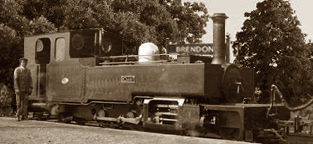
early days at Brendon
As noted at Watersmeet, Brendon was
originally intended to be the intermediate passing-point between Barbrook and
County Gate; as such two platforms were provided along with a lengthy loop
that extended under the road-bridge, broken with a crossover enabling part of
it to be used as a goods loop. However, since County Gate is only 1.5 miles
away, with Barbrook being 5 miles in the opposite direction, it was quickly
observed that westbound trains were forced to wait a considerable time to
cross.

Brendon as originally built
As such, once the railway was open
throughout and funds made available, Brendon’s passing-loop was moved to
Watersmeet and the second platform made derelict. The goods loop remained
however, but although Brendon village has kept up a regular flow of
passengers through the years, goods traffic has always been light, and so the
loop was removed and the goods yard closed by the Southern Railway as part of
a cost-cutting purge in 1932. Today Brendon has no loop or siding, and the
former Signal Box is now a conservatory in which the stationmaster grows a
fine crop of tomatoes. The station itself is operated as a manned halt, with
a minimum staff of the stationmaster and his wife, who also acts as ticket
officer and parcels clerk. They’ve made a comfortable home for themselves in
the station building, and Brendon continues to win prizes in the Southern
Railway’s vegetable and flower-growing competitions, the former ‘up’ platform
now being replete with a magnificent display of colourful blooms.

Brendon in later years.
There are a few local passengers
trickling onto the platform, but they’re not boarding just yet; they’ll be
waiting for the fast railcar-service to Barnstaple, due to pass us ahead at
County Gate. So after setting down a handful of tourists who wish to take in
the pleasures of Barbrook, Johnny gives Lyn a full head of steam and she sets
off under another road bridge with a will, once again climbing with the
gradients up the valley. The river has eased off its own ascent momentarily,
so once again we begin to gain ground on it, scrambling up the hillsides
through a long section of straight track to where we round a long sweeping
corner, high above the river.
This curve, ‘Scotch Corner’ to the railwaymen, is not particularly tight or
arduous, but it is treated with respect by drivers; passengers who seek
explanation would do well to look down into the valley towards Southernwood
Farm, and they’ll see a strange furrow torn into the ground, like a
grassed-over gash leading down from the railway, all the way to the
riverside. This is the grave-marker of the contractor’s locomotive
Kilmarnock, and the source of Scotch Corner’s name.
Kilmarnock was a diminutive 0-4-0ST built by Andrew Barclay & Co. in
Scotland, owned and used by Nuttall’s in the construction of the Lynton &
Barnstaple. After the contractor fell into bankruptcy, Kilmarnock was left on
the hands of the L&B, and would have most likely been sold for scrap had they
not in turn leased it to McAlpines for use in building the Minehead line.
After this seeming reprieve however, Kilmarnock met an unfortunate end one
day in 1903, when the construction office received an unfortunate message
that ‘the wee engine’s taken a bit of a jump into the valley’.
As it had transpired, a slab of stone had fallen from the wall of the ledge
on which the railway is carried at this point, and in the weak light of
morning, Kilmarnock’s driver had not seen the obstruction until too late;
whilst no-one was hurt, the engine was thrown off the line and, train in tow,
careened down the hillside and drowned herself in the river. To this day
there are occasional rockfalls along this section, and making a daily
inspection to prevent a second derailment at Scotch Corner has fallen to the
County Gate track-gang, known on the railway as the County Gate Desperados.
Some of the Desperados are just ahead now, checking on a recently relayed
section of track and ensuring the ballast is packed firmly, and so Johnny
eases off the power and eases Lyn past at a respectable walking pace; he’s
got no need for speed at this point, as he’s almost at the lip of a short
falling gradient and can afford his engine a breather. As he passes the
track-gang he affords them a wave and a salute on the whistle; most crews on
the railway hold the Desperados in high respect, as few other track-gangs on
the line have to deal with such a lengthy or arduous section (Watersmeet to
the Summit, including the lengthy Porlock Tunnel). Their task is furthermore
made difficult by frequent manpower shortages, yet through good humour and
hard work, they always manage to keep the trains running to time, on as
smooth and even a permanent way as could be asked for.
As we leave the Desperados behind, Johnny gives another whistle, and an
unfamiliar croaking blare answers back, the sound of an air-horn. Passengers
who noticed Kilmarnock’s trail of destruction are now rewarded with another
curious sight; below us and at right angles, a second railway line emerges
from a tunnel and crosses the river, before swinging hard right through a
small yard to parallel us on the opposite side of the valley. This is the
Light Railway of the Glenthorne Harbour Authority, opened at the same time as
this section of the M&B. On the curve is a small wooden platform, at which a
few passengers are disembarking from a curious contraption; two former coach
bodies connected by articulated bogies to a central diesel-power unit; the
Glenthorne Railcar. Painted in a maroon and cream livery it looks both
careworn and unserviceable, yet can still put on a surprising turn of speed;
many a driver has been tempted to race it to the junction round the corner at
County Gate, but Johnny’s got no such urge; he knows that the County Gate
signalman must always give priority to the harbour line. So as the railcar
sets off and draws ahead he continues to let Lyn roll on at her own pace.
Beneath us in the valley’s bottom are a cluster of houses. One of two
worker’s villages provided for employees of the Glenthorne Harbour Authority,
this one carries the simple and poetic name of Doone. The other is the
village of County Gate (or more properly County-Gate-On-The-Railway, as it
appears in the census), but we’ll get there shortly.
The residents of Doone were first provided with little else beyond a small
shop and a Catholic Church, built in 1909 for the harbour’s sizable number of
Catholic employees and dedicated to Saint Thomas Aquinas, the Patron Saint of
Education. Appropriately enough, the Hallidays shortly thereafter provided
finance to establish a school in Doone for the children of their staff, which
has had to enlarge as children from surrounding villages are now welcomed. In
addition a public house has sprung up, ‘The Lorna Doone’ and lastly the
Alberry School, a small manor house built as a retirement home for a wealthy
entrepreneur, who has since developed it as a school for the training of
guide dogs.
As it is well served by the Glenthorne Harbour Railway, no halt is provided
on the main line for Doone, and so as we skirt the picturesque little
model-village we have no need to stop, and once again Johnny shuts off the
blower and his fireman closes the fire doors as we swing into the hillside,
first through a deep and sudden cutting, and then into the second tunnel on
the railway. Ashton Cleeve Tunnel is only 109 yards long, but it is tightly
curved, swinging us around through almost ninety degrees. As with the others,
it is unlined, and from its rough-hewn rock portal we emerge from the wooded
hillside onto the East Lyn viaduct, widely regarded as the prettiest on the
line, perfectly scaled to its setting and a sure draw for the eyes of people
travelling through or above the valley.
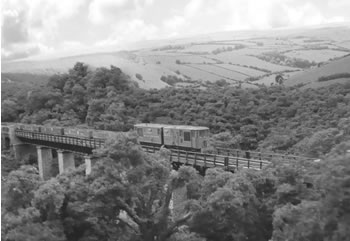
'River Avill' crosses the
East Lyn Viaduct during its trials in 1935 - photo Armstrong Whitworth
As we reach the end of the viaduct the Harbour Railcar passes beneath us on
an arch built into the parapet and skirts around through the fields, while we
coast down a short section of 1-in-40, Johnny gently braking us to a stop at
the home signal for County Gate.
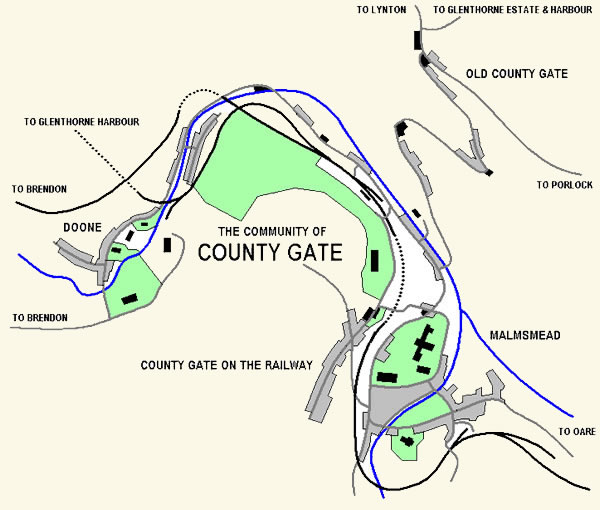
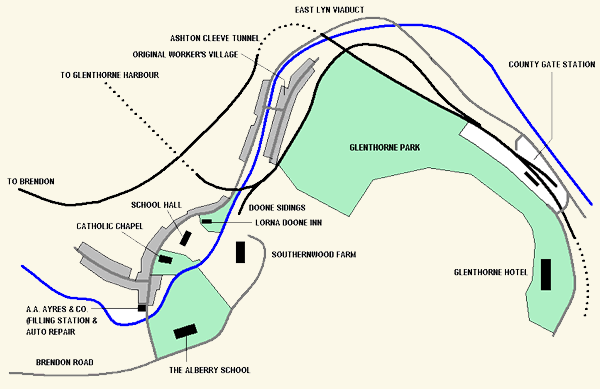
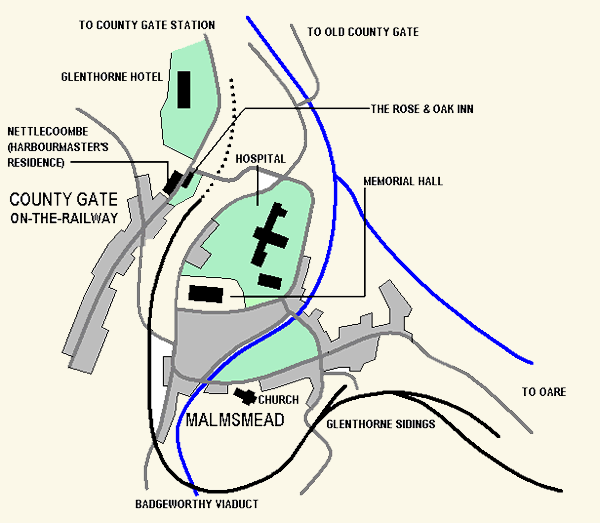
This entire section of railway was not included in the original survey; as at
Lynton, George Newnes managed to get the initial plans rejected in the Lords,
though in this case his intentions were not disguised as being in aid of the
proletariat. A short mile along the valley from here, the railway was to pass
across the valley from Oare Manor, and Newnes was able to convince the
residents that the railway would not only be an eyesore, but devalue their
property, and so win them to his cause. In fighting back, Halliday agreed to
a deviation that would take the railway behind the manor, and also the
provision of a private halt. As with Lynton however, the deviation would
require a break in the carefully surveyed gradients and several substantial
works, two of which, Aston Cleeve Tunnel and the East Lyn viaduct, we have
already seen.
As we wait at the signal though, it’s difficult to imagine the hard-fought
political battles which were waged over the rights to put a railway through
this peaceful landscape. To our left opens out a view over open fields down
to the valley floor, and to our right is the pleasant slope of Southern Wood.
Deforested as a source of timber when the railway first arrived, the hillside
has subsequently become part of the grounds of the Glenthorne Hotel, and
replanted as an extensive arboretum. Trees have been carefully chosen and
composed to form a idyllic scene (and to hide the station from the hotel)
through which guests might wander at ease, though woe betide any who damage
the plants, as the hotel’s head groundskeeper is zealously (and rightly)
protective of his charges.
A timeless moment later, the signal arm shifts to ‘clear ahead’, and with
another cheery toot on her whistle. Lyn eases us forward into County Gate
Station, straight through the loop throat, then over the junction with the
harbour branch that sweeps up from the left, and finally into the platform;
the Harbour Railcar is in its bay to our left, her driver at an open hatch in
the power unit, working on the two Gardner diesel engines inside, and by the
persistent sound of hammer against metal and colourful language dying the air
blue as surely as the accompanying clouds of diesel, having a hard time of
it.

the first railcar, no 200,
arrives at County Gate from Lynton
Also waiting for us in the ‘up’ platform is another railcar, this one in a
striking aquamarine livery, the bold legend SOUTHERN and Atlantic
Airstream painted in trim yellow
down its flanks. This unit, 303, is one of five railcars currently in use on
the railway, the result of an experiment which has left many on the line both
excited and apprehensive, the introduction of diesel power to supplement
steam. Welcomed by most and decried by some, the presence of diesel traction has
become more apparent in the past year; as the production railcars are of
identical design and use standardised parts, Eastleigh has been able to
deliver two batches in just an eight-month period;
301-303: Three-car units (delivered October 1934)
304-305: Four-car units (delivered May 1935)
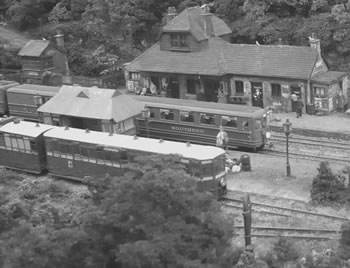
railcar 302 alongside the
Glenthorne railcar at County Gate
Prior to these units being delivered, two separate prototypes (200 and 201),
delivered in January and June of 1933 respectively, were tested on the line
as proof-of-concept; having demonstrated themselves a success, both have now
been sold to the Glenthorne Harbour Authority to supplement their passenger
services to Glenthorne Harbour and Porlock, where they earn a respectable
living transporting local passengers and tourists. The harbour service
however, operated mostly by the careworn vehicle in the bay platform, is all
about tourism, with many being willing to pay a pretty penny to enjoy the
spectacular cliffside route, overlooking the sea. We shall be getting a
chance to view this sight ourselves shortly, though (thankfully) without the
added thrill of charging along in a lightly-built railcar that creaks on
every turn, and who’s driver has a worrying tendency to drive his charge
onwards like a chariot in the Coliseum.
The main-line unit adjacent to us, the aquamarine 303, makes a far braver
sight, indeed, since we are leaving our train here, we can indulge ourselves
in studying her closer, for now with a wave and a whistle, Johnny sets Lyn in
motion once more, and leaving us behind she steams away from the station and
out of sight under the road bridge leading to County Gate village; moments
later her vibrant exhaust is muffled by the tunnel beyond the road bridge,
and abruptly silence returns to the station, broken only by the steady thrum
of 303’s engine, and the not-so-steady belches emitting from the Glenthorne
Railcar as its driver (with judicious application of hammer and quite an
impressive war-cry) finally persuades its second Gardner engine to fire. Due
to being constructed from whatever was to hand, the railcar features two such
power-plants; each with 3 forward gears and one reverse.
Somewhat blue in the collar, and trying to avoid the ‘helpful’ advice being
yelled across the track by his main-line counterpart, the Glenthorne driver
checks his watch and quickly makes his way forward to test the railcar’s
brakes; the harbour line features such prolonged gradients as to make the
descent from Woody Bay to Barbrook seem like a Sunday School picnic, and so
tests of the vacuum system are mandatory under the terms of the Harbour
Authority’s Light Railway Order.
As the railcar emits a series of hisses and thuds, across the way 303
continues to idle powerfully and confidently, and she has every right to;
indeed this particular unit holds the railway’s ‘speed record’ for a service
train, Minehead to Barnstaple in two hours, twenty minutes (at an average
speed, including station stops, of 20mph). On a non-stop test run conducted
at night, when all signals and points could be set in her favour, unit 305
made the trip in seventy-nine minutes (an average of 35mph throughout). It is
these formidable abilities, combined with the comfort yielded to passengers
by their articulation, that have allowed the railcars to win back local
traffic, thus snubbing the rival buses.
Suddenly, guards on both platforms let out piercing shrieks on their
whistles, and the two railcars yelp back in unison, Now occurs a sight seen
nowhere-else on the network, as the two railcars pull out together, the
harbour train seemingly about to collide with 303, before it suddenly swings
across the points and down the branch towards the harbour, while 303 lets
into the short, sharp climb to the viaduct with a smooth thrum. It’s almost
certain that their drivers (both younger men) will be itching to see which
can reach Doone first, and in all likelihood, the passengers will be egging
them on, but safety always comes foremost and so any ‘racing’ will most
assuredly be of a ‘tame’ nature.
It is such moments that lend County Gate the title of ‘busiest station on the
railway’ in the summer months, and yet once the two railcars have vanished
out of sight (roaring their horns in the distance as they cross at the
viaduct), abrupt silence falls on the station as surely as a muffling
blanket.
Now, we may explore